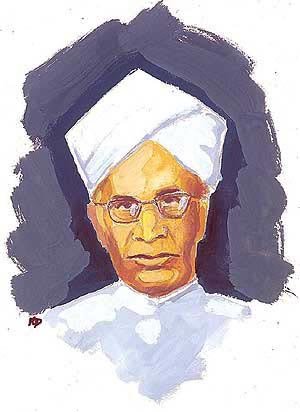
Sarvepalli Radha-krishnan was born in Tirutani on September 5, 1888 into a poor brahmin family. His father Sarvepalli Veeraswami was employed on a meagre salary in the zamindari. His mother’s name was Sitamma. It was difficult for Radhakrishnan’s father to educate him with a meagre income and a large family to take care of.
Radhakrishnan went through most of his education on scholarships. He initially went to school in Tirutani and then to the Lutheran Mission School in Tirupati for his high school. He joined the Voorhee’s College in Vellore but switched to the Madras Christian College at the age of 17. He chose philosophy as his major and attained a B.A. and M.A. in the field. He was afraid that his M.A. thesis, ‘The Ethics of the Vedanta’ would offend his philosophy professor, Dr. A.G. Hogg. Instead, Dr. Hogg commended Radhakrishnan on doing an excellent job. Radhakrishnan’s M.A. thesis was published when he was only 20.
Radhakrishnan was married to Sivakamuamma at the age of 16 while still in Vellore. Radhakrishnan accepted an Assistant Lectureship at the Madras Presidency College in 1909. While at the College, he mastered the classics of Hindu philosophy, namely the Upanishads, Bhagvad Gita, Brahmasutra, and commentaries of Sankara, Ramunuja and Madhava. He also acquainted himself with Buddhist and Jain philosophy. At the same time he read philosophical commentaries of Plato, Plotinus, Kant, Bradley, and Bergson. Later on in his life, he studied Marxism and Existentialism.
In 1918, Radhakrishnan was selected as Professor of Philosophy by the University of Mysore.
Radhakrishnan’s books and articles, drew the attention of Ashutosh Mukerjee, Vice Chancellor of Calcutta University. He nominated Radhakrishnan to the prestigious George V Professor of Philosophy at the Calcutta University, 1921. In 1923, Dr. Radhakrishnan’s ‘Indian Philosophy’ was published.
Radhakrishnan was called to Oxford University, England, to deliver the prestigious ‘Upton Lectures’ on ‘The Hindu View of Life.’ The lectures were followed by an invitation to head the Department of Comparative Religion at Oxford. A philanthropist, Spalding, created a professorship for Radhakrishnan to teach Religion and Ethics at Oxford.
Radhakrishnan used his lectures as a platform to further India’s cause for freedom. He thundered, “India is not a subject to be administered but a nation seeking its soul.”
In 1931, Radhakrishnan was elected Vice Chancellor of the Andhra University.
In 1939, Radhakrishnan became the Vice Chancellor of the Benaras Hindu University.
In 1949, Dr. Radhakrishnan was appointed ambassador to the Soviet Union. The appointment raised many eyebrows because people wondered what kind of an impression Radhakrishnan, a student of idealist philosophy, would make on Joseph Stalin, an ardent communist.
On April 5, 1952, a few days before Radhakrishnan’s departure for India, Stalin called on Radhakrishnan. Radhakrishnan records Stalin’s face being bloated. Radhakrishnan patted him on the cheek and on the back. Stalin said, “You are the first person to treat me as a human being and not as a monster. You are leaving us and I am sad. I want you to live long. I have not long to live.” Stalin died six months later.
Radhakrishnan was elected Vice-President of India in 1952. The
Dr. Radhakrishnan was honoured with the Bharat Ratna in 1954. Around the same time, an 883-page compilation titled ‘The Philosophy of Dr. Sarvepalli Radhakrishnan’ was released in America.
In 1956, Radhakrishnan’s devoted wife, Sivakamuamma, passed away after sharing 50 years of married life. The couple had five daughters and a son.
After serving two terms as Vice-President, Radhakrishnan was elected President of India in 1962. Radhakrishnan’s tenure as President was marked by the disastrous Indo-China war of 1962, his state visit to the United States in 1963, the end of the Nehru-era with Nehru’s death in 1964, and India’s victorious performance against Pakistan in 1965 under Lal Bahadur Shastri. Radhakrishnan guided each of the Prime Ministers wisely and helped see India through those trying years safely. Radhakrishnan refused to continue for another term as President after his term ended in 1967.
At the age of 79, Dr. Radhakrishnan returned to Madras in May 1967 to a warm homecoming. He spent his last years happily at his house ‘Girija’ in Mylapore, Madras.
Dr. Radhakrishnan died on April 17, 1975.

